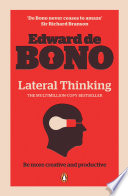

Lateral thinking is a problem-solving approach that involves looking at a situation from different angles rather than following traditional logic. This concept was popularized by Edward de Bono, who emphasizes that conventional thinking often restricts creativity and innovation. Lateral thinking encourages individuals to break free from established patterns and explore unconventional solutions. By employing techniques such as provocation, random entry, and challenge, individuals can generate new ideas and perspectives. This approach is particularly valuable in fields that require creativity, such as marketing, product development, and design.
Continue readingCreativity is not just an innate talent; it can be cultivated and developed through practice. De Bono argues that creativity is essential for problem-solving and innovation in any domain. He introduces various tools and techniques to enhance creative thinking, such as brainstorming and mind mapping. By fostering a creative mindset, individuals can approach problems with a fresh perspective, leading to innovative solutions that may not have been considered before. This idea is crucial for professionals in fast-paced industries where adaptability and innovation are key to success.
Continue readingDe Bono outlines several specific techniques for lateral thinking that can be applied in various contexts. These include the 'Six Thinking Hats' method, which encourages individuals to look at a problem from different perspectives (emotional, analytical, creative, etc.), and the 'Random Word' technique, where a random word is used to stimulate new ideas related to the problem at hand. These techniques help to break the mental blocks that often hinder innovative thinking and allow teams to collaborate more effectively by considering diverse viewpoints.
Continue readingOne of the core principles of lateral thinking is the importance of challenging existing assumptions and beliefs. De Bono suggests that many problems are perpetuated by unexamined assumptions that limit the scope of possible solutions. By questioning these assumptions, individuals can uncover new opportunities and develop innovative strategies. This approach is particularly relevant in industries that are undergoing rapid change, where established practices may no longer be effective. Challenging assumptions encourages a culture of inquiry and openness, which is vital for continuous improvement.
Continue readingProvocation is a key technique in lateral thinking that involves making bold statements or asking provocative questions to stimulate new ideas. De Bono explains that provocation can disrupt conventional thought patterns and lead to unexpected connections. This technique encourages individuals to think outside the box and explore ideas that may initially seem impractical or absurd. By embracing provocation, teams can unlock innovative solutions that challenge the status quo and drive progress. This approach is particularly useful in brainstorming sessions where creativity is essential.
Continue readingLateral thinking is not just an individual skill; it can also be implemented within teams to enhance collaboration and innovation. De Bono emphasizes the importance of creating an environment that encourages open communication and the sharing of ideas. By fostering a culture of lateral thinking, organizations can tap into the collective creativity of their teams, leading to more effective problem-solving and decision-making. Techniques such as group brainstorming, role-playing, and collaborative idea generation can help teams leverage lateral thinking for greater impact.
Continue readingLateral thinking has practical applications across various fields, including business, education, and healthcare. De Bono provides numerous examples of how organizations have successfully implemented lateral thinking techniques to solve complex problems and drive innovation. These case studies illustrate the transformative power of lateral thinking in overcoming challenges and seizing opportunities. By understanding these real-world applications, readers can better appreciate the relevance of lateral thinking in their own professional contexts and consider how they might apply these principles to their work.
Continue reading